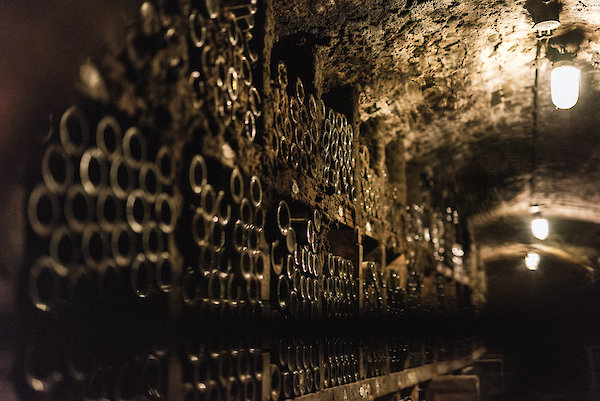Winery
Cellar
We harvest between September and December. A vineyard will often be selectively harvested two or three times in succession, in order to achieve even more subtle, authentic wines. The bunches for all wines are selected by hand and placed in small colour-coded crates, with the healthy grapes separated from those that are overripe and shrivelled. They are then transported as quickly as possible to the cellar and transferred into extremely gently working pneumatic presses: Their operating pressure of just 1 bar is equivalent to the force of a handshake between friends. Immediately after this process, the crates used for harvesting are washed with fresh well water.
We are committed to a most careful handling of the vinification process, from receipt of the grapes to bottling. To retain their aroma, the musts are fermented cool, not cold, in stainless steel or wood. Aging takes place in a climatized cellar with high humidity. Depending on the varietal, the wines remain from three to 18 months in the barrel or tank, reserves for sparkling wines may mature for several years.
The Bründlmayer cellar uses the natural rules of gravity: on top of the roof, photovoltaic cells capture the sun’s energy, while below, the grapes are received and pressed. Then, driven by gravity only, the must flows slowly down to the next floor, directly into the fermentation vats. Later, for maturation, the wines travel down another level into the wooden casks of the old earth cellar which connects seamlessly to the 21st-century installation. The difference in altitude avoids the need for pumping, which would traumatize the wines. Under the foundations, pipes are installed for the utilization of geothermal energy. Solar energy and the simple use of fresh well water for cooling, all help to achieve an eco-friendly energy balance. The Bründlmayer cellar is ISO 22000 certified.
The Sparkling Wine
During the first weeks of September, the grapes best suited for our Sekt base wines are selected. These grapes should not be too sweet; their acidity should taste fresh and lively, but not aggressive. After fermentation, we blend the cuvées for a classic Bründlmayer Brut, a charming Brut Rosé, and the dry and multifaceted Extra Brut. In special years, with superb conditions for sparkling base wines, a vintage Sekt may be manufactured. All steps of production are performed in our cellar using best craft trade practices. For the process of remuage we use wooden riddling racks. We disgorge at cellar temperature and mark the date of disgorgement on the back label. Ideally, Bründlmayer Brut should be enjoyed 6–36 months after disgorging.
“The Bründlmayer Brut has the creaminess and elegance that make it seem on equal par with the best vintage champagnes. Maybe the best Sekt in the German-speaking world...”Stuart Pigott “The Good Sekt Guide”
Malolactic Fermentation – Yes or No ?
The question of malolactic fermentation – yes or no – is answered here by Willi Bründlmayer:
“With Grüner Veltliner and Riesling, freshness and fruit should be preserved and, in this respect, the acidity is an important component. Only where depth and warmth are more important than freshness and fruit – that is, with red wines and some vintages of Chardonnay and sparkling wines – then organic acid reduction is implemented.
With the sparkling wine, Sekt, the carbonic acid brings the tingling freshness; a slightly softer, warmer base wine produces an interesting tension between freshness and warmth, resulting in a contrast that leads to a complex taste.”
Storing for Calm Maturation
Depending on the grape variety, the wines remain in the barrel from six to 36 months. After bottling, the bottles are stored for some time in a standing position. This gives the corks the opportunity to relax again without contact with the wine, therby minimising the cork risk.
Another very important quality factor is the wholesomeness and purity. In order to achieve this, environmentally friendly management of the vineyards is important, cleanliness in all aspects of work in the cellar must be maintained and fermentation carbon dioxide must be retained because it is present in the wine from the outset and is a pleasant, natural and wholesome preservative. Numerous important components of the wine are connected to the preservation of fermentation carbon dioxide.
The Collection
Since 1947, the most valuable wines of each vintage have been archived in the 700-year old “Vinothek”. Intensive tastings of old and young vintages develop intimate knowledge of the vineyards, vintages and wine ageing styles.
With each of our wines we hold a part of our identity in our hands, proof of a fulfilling relationship between mankind and nature during a given period of time.
“Willi Bründlmayer is now considered to be amongst the best of the more-than-a-few very, very good Austrian winemakers.”Erich Grasdorf, “Neue Zürcher Zeitung”







